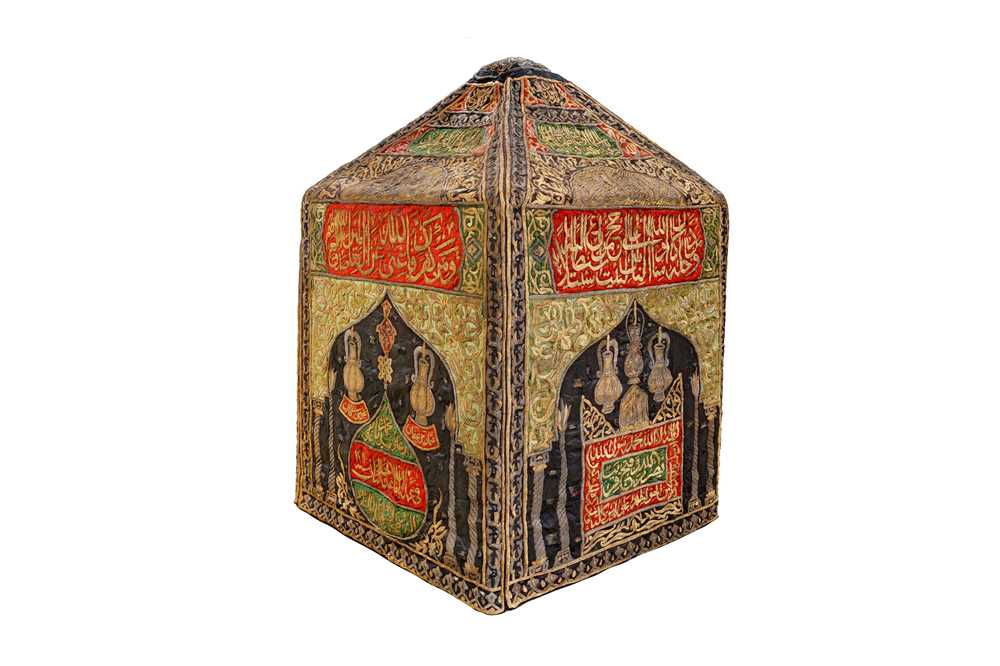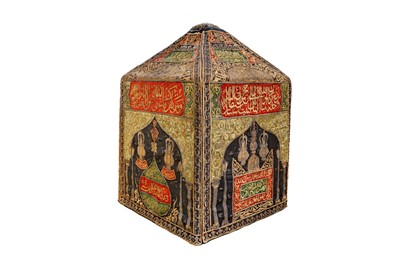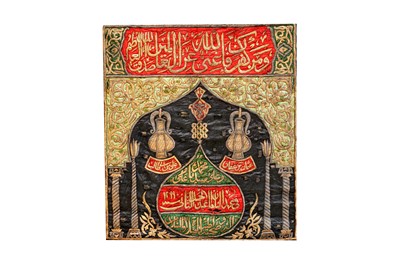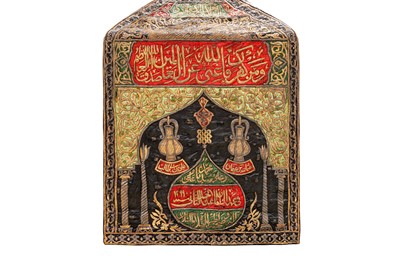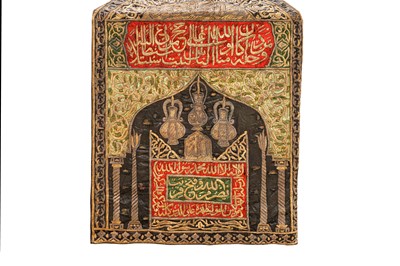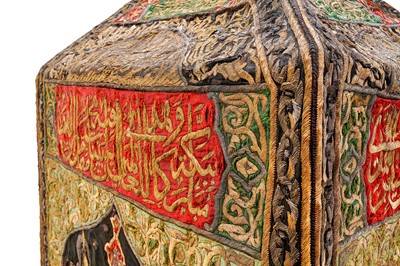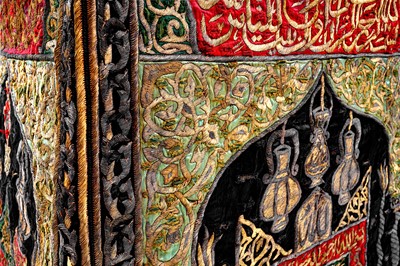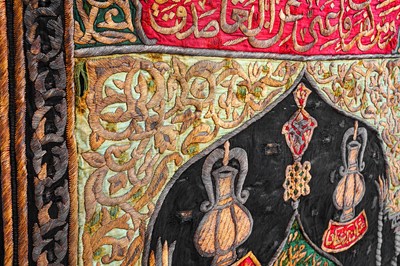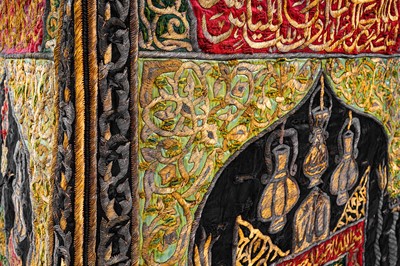31st Oct, 2023 14:00
Islamic & Indian Art
A CEREMONIAL MAHMAL (PALANQUIN) MADE FOR HAJJ
Egypt, made for the Hajj pilgrimage of 1299 AH (1881 - 82 AD), bearing the name of the Ottoman Sultan Abdul Hamid II (r. 1876 - 1909)
A CEREMONIAL MAHMAL (PALANQUIN) MADE FOR HAJJ
Egypt, made for the Hajj pilgrimage of 1299 AH (1881 - 82 AD), bearing the name of the Ottoman Sultan Abdul Hamid II (r. 1876 - 1909)
Of cubic shape with a pyramidal top, the ceremonial palanquin of black, pale blue, red, and green silk, all sides elaborately worked in metal threads with a programme of symbolic motifs and sacred Quranic passages, fitting on a later customised metal structure, quoting sura Al-Towhid (112) at the very top of the pyramid; the surrounding areas of green silk to the top and the lobed red cartouches beneath worked with texts relating to the pilgrimage of Hajj and Prophet Ibrahim; on the longer vertical sides sura Al-Imran (3), verses 96 and 97; sura Al-A’raf (7), verse 89; sura Al-Asra’ (17), verse 84; and sura Al-Baqara (2), verse 125; each side opening to a black ground worked with traditional mosque lamps suspended from a cusped arch supported by twisted columns, flanking symbolic motifs, the front a pointed dome referring to the date of commission 1299 AH, and the terminus post quem, ‘the age of Sultan Abdul Hamid Al-Thani’, also known as Abdul Hamid II, lined in ecru cotton, ca. 205cm x 133cm x 133cm, the vertical section 150cm high.
The artistic workshop in Cairo in charge of making sacred textiles for the Islamic holy sites, known as the Dar al-Kiswa, operated from 1817 until 1997. It was in this very workshop that the kiswah, the ornamental textile covering Ka’ba, was produced annually. This and other sacred textiles were conveyed each year across hundreds of miles of desert from Cairo to Mecca on camels among hajj pilgrims. At its peak at the start of the 20th century, the Dar al-Kiswa workshop employed over a hundred craftsmen appointed to the production of these religious fabrics. The mahmal, a ceremonial passenger-less palanquin carried on a camel, was one such textile. It symbolised the political power of the Sultan who sent it, demonstrating their custody of Islam's holiest sites. The first sultan to be firmly associated with the sending of the mahmal palanquin was Baybars (r. 1260 - 77), and the tradition carried on almost uninterrupted until the mid-20th century.
The mahmal’s parade through the city months before the caravan's scheduled departure was greatly anticipated and conceived as an exciting event that served as an advertisement for the caravan operators. These textiles became the true mascot and symbol of the hajj procession, thanks also to their sheer size and brightness which provided those falling behind with a focal point in the desert. The arrival of the mahmal in Mecca was a major event during the pilgrimage season. Pilgrims flocked from every corner to see the progress of the splendid procession. This symbolic assertion of the sultan’s hegemony led the ‘town on the move’. Each mahmal had an intricately embroidered textile cover or sitr. A number of extra textile panels were made to cover the litter including an elaborate processional covering, and others for the 50-odd days of the journey from Cairo, in case any damage occurred in transit. The motifs of the mahmal embroidery included mosque lamps and cenotaphs representing the tomb of the Prophet, considered one of the very visual symbols the palanquin is supposed to represent. But the mahmal was not supposed to stay in Mecca: it always made its way back to Cairo with the returning caravan. Having endured the pilgrimage journey and reached the cradle of Muslim sanctity, this tent-like structure earned a blessed status, and people desired to touch it and place handkerchiefs inside it to partake of its blessings. Even the camel that carried the mahmal was rewarded for its labour: should he return safely from the journey, he was going to be exempted from carrying any load for the remainder of its life.
For further reference, please see Venetia Porter (ed)., Hajj, Journey to the Heart of Islam, British Museum exhibition catalogue, 2012, pp. 139 - 142. For a group of four black and white photographs featuring a Mahmal in procession, please see these Rooms, A Middle Eastern Journey auction, 12 July 2023, lot 355.
Sold for £11,250
Includes Buyer's Premium
Do you have an item similar to the item above? If so please click the link below to submit a free online valuation request through our website.
